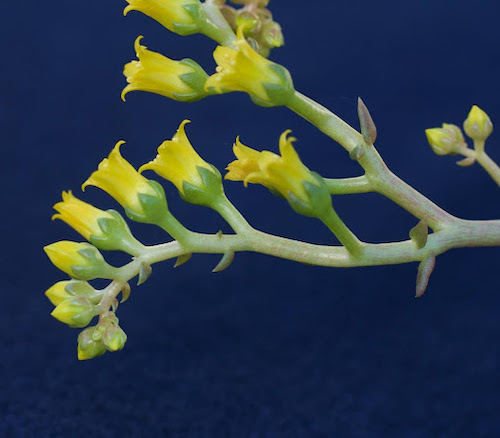Genetic Research Aids in Naming New Rare Succulent Species from Orange County

Santa Barbara, Calif. – March 27, 2024 – A new rare species of succulent plant from Orange County has been named by Stephen McCabe, emeritus director of research at the UC Santa Cruz Arboretum, Kristen Hasenstab-Lehman, Ph.D., conservation geneticist and lab manager at Santa Barbara Botanic Garden, and Matt Guilliams, Ph.D., Tucker Systematist and curator of the Clifton Smith Herbarium at Santa Barbara Botanic Garden. The naming of new species is part of an effort by multiple entities to help conserve the many threatened species in the genus Dudleya, which are also known, ironically, as liveforevers.
The species, Dudleya chasmophyta, the crevice-loving Dudleya, was named in the California Botanical Society journal Madroño. When naming the plant, McCabe, along with colleagues Hasenstab-Lehman and Guilliams, opted not to name it after a specific person or place. Instead, they derived its new name from its affinity for dwelling in crevices, thus the name chasmophyta. Local experts Fred Roberts and Ron Vanderhoff of the California Native Plant Society helped arrange access to the plants via the U.S. Forest Service, using their knowledge of Orange County botany.
Although the range of the new species is incredibly small, occupying one cliff band in one canyon, it is not as threatened by poaching as other species of Dudleya that have been in the news in the last few years. That’s because the cliffs on which it grows are steep and have friable rocks that make climbing unsafe. Private property, thorny shrubs, and poison oak also protect the plants. Two fires have impacted surrounding areas and the top and bottom of the population, but it is likely that most of the plants have survived the fires, according to Roberts and McCabe. Vanderhoff notes that this is the second species to be known only from Orange County, the other being the Laguna Beach Dudleya.
Dudleya chasmophyta had rarely been visited and was previously considered to be part of a federally endangered species from Malibu Canyon in Los Angeles County. David Verity found the original Orange County plants in about 1950 and considered them likely to be the same as the ones in Malibu Canyon 60+ miles away. Unfortunately, he did not preserve a specimen.
Genetic work conducted by Hasenstab-Lehman provided supporting evidence that the species was distinct. “Our genomic data provided clear evidence that the new species, D. chasmophyta, did not share the same branch in the evolutionary tree of life with the federally threatened Santa Monica Mountains Dudleya (Dudleya cymosa ssp.ovatifolia), a subspecies of the Malibu Canyon Dudleya,” Hasenstab-Lehman explains. “We know now both these rare liveforevers are even more restricted in the areas they live on the California Coast.”
With the separation into two species and after fires in Malibu Canyon, the Malibu Canyon Dudleya is now considered even more critically rare than when it was listed as endangered. “Without the name, many of the agencies will not recognize it as something that needs protecting,” explains McCabe. Seeds have now been collected for seed banks in case poaching, climate change, landslides, or some catastrophe affects the new species.
The different gardens and groups concerned with the rare Dudleya are working to preserve habitat, seed-bank populations, conduct research, and educate the public about buying responsibly propagated plants, not plants poached from the wild.
Hasenstab-Lehman, Guilliams, and McCabe have submitted genetic research for publication that bolsters their argument for naming the new species. McCabe is also finishing up a phase of a long-term research project with Channel Islands National Park by publishing an article about Dudleya of the Channel Islands. The article in the Cactus and Succulent Journal may help the park, the Nature Conservancy, and the Navy plan for conservation of Dudleya on those islands.
###
About UC Santa Cruz: A global research university, UC Santa Cruz is part of the world’s most celebrated system of public higher education, and stands among the most renowned institutions of higher learning. Leading at the intersection of innovation and social justice, UC Santa Cruz faculty and students conduct transformative research and scholarship that serves society. Undergraduate students experience a small liberal arts college environment with the depth and rigor of a major research university through the pairing of high-impact research with 10 tight-knit residential colleges – a rare combination among U.S. public universities. UC Santa Cruz shares the distinction of being the youngest member of the Association of American Universities and one of only five members that is both a Hispanic-Serving Institution and an Asian American and Native American Pacific Islander-Serving Institution. To learn more, visit ucsc.edu.
 Donate
Donate